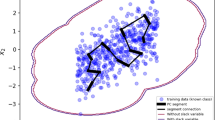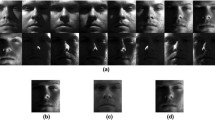Abstract
A simple yet effective learning algorithm, k locally constrained line (k-LCL), is presented for pattern classification. In k-LCL, any two prototypes of the same class are extended to a constrained line (CL), through which the representational capacity of the training set is largely improved. Because each CL is adjustable in length, k-LCL can well avoid the “intersecting” of training subspaces in most traditional feature classifiers. Moreover, to speed up the calculation, k-LCL classifies an unknown sample focusing only on its local CLs in each class. Experimental results, obtained on both synthetic and real-world benchmark data sets, show that the proposed method has better accuracy and efficiency than most existing feature line methods.







Similar content being viewed by others
References
Blake CL, Merz CJ (1998) UCI repository of machine learning databases. Available at http://www.ics.uci.edu/~mlearn/MLRepository.html
Chen JH, Chen CS (2004a) Object recognition based on image sequences by using inter-feature-line consistencies. Pattern Recognit 37:1913–1923
Chen JH, Chen CS (2004b) Reducing svm classification time using multiple mirror classifiers. IEEE Trans Syst Man Cybern Part B: Cybern 34(2):1173–1183
Chen K, Wu TY, Zhang HJ (2002) On the use of nearest feature line for speaker identification. Pattern Recognit Lett 23(4):1735–1746
Du H, Chen YQ (2007) Rectified nearest feature line segment for pattern classification. Pattern Recognit 40(5):1486–1497
Fukunaga K, Hummels DM (1989) Leave-one-out procedures for nonparametric error estimates. IEEE Trans Pattern Anal Machine Intell 11:421–423
Gao QB, Wang ZZ (2005) Using nearest feature line and tunable nearest neighbor methods for prediction of protein subcellular locations. Comput Biol Chem 29:388–392
Gao QB, Wang ZZ (2007) Center-based nearest neighbor classifier. Pattern Recognit 40:346–349
He R, Ao M, Xiang SM, Li SZ (2008) Nearest feature line: a tangent approximation. In: Chinese conference on pattern recognition 2008, October, Beijing, pp 1–6
Jollife IT (2002) Principal component analysis, 2nd edn. Springer, New York
Kohavi R (1995) A study of cross-validation and bootstrap for accuracy estimation and model selection. In: 14th Int Joint Conf Artificial Intel, vol 2, pp 1137–1143
Lee J, Zhang C (2006) Classification of gene-expression data: the manifold-based metric learning way. Pattern Recognit 39(12):2450–2463
Li SZ (2000) Content-based classification and retrieval of audio using the nearest feature line method. IEEE Trans Speech Audio Process 8(5):619–625
Li SZ, Lu J (1999) Face recognition using the nearest feature line method. IEEE Trans Neural Netw 10(2):439–443
Li SZ, Chan KL, Wang C (2000) Performance evaluation of the nearest feature line method in image classification and retrieval. IEEE Trans Pattern Anal Machine Intell 22(11):1135–1139
Ma L, Wang YH, Tan TN (2002) Iris recognition using circular symmetric filters. In: Proceeding of the sixteenth international conference on pattern recognition, vol. 2, Quebec, Canada, 11–15 August, pp 414–417
Manocha S, Girolami MA (2007) An empirical analysis of the probabilistic k-nearest neighbour classifier. Pattern Recognit Lett 28:1818–1824
Orozco-Alzate M, Duin RPW, Castellanos-Domínguez CG (2009) A generalization of dissimilarity representations using feature lines and feature planes. Pattern Recognit Lett 30:242–254
Osuna E, Girosi F (1999) Reducing the run-time complexity of support vector machines. In: Advances in kernel methods: support vector learning. MIT Press, Cambridge, MA, pp 271–284
Pang YW, Yuan Y, Li XL (2007) Generalized nearest feature line for subspace learning. Electron Lett 43(20):1079–1080
Pang YW, Yuan Y, Li XL (2009) Iterative subspace analysis based on feature line distance. IEEE Trans Image Process 18(4):903–907
Ripley BD (1994) Neural networks and related methods for classification. J R Stat Soc Ser B (Methodol) 56(3):409–456
Samaria F, Harter A (1994) Parameterisation of a stochastic model for human face identification. In: Proceedings of second IEEE workshop on applications of computer vision, Sarasota, FL, December, pp 138–142
Zhao L, Qi W, Li SZ, Yang SQ, Zhang HJ (2001) Content-based retrieval of video shot using improved nearest feature line method. In: 2001 IEEE international conference on acoustics, speech, and signal processing (ICASSP), vol 3, Salt Lake City, USA, 8–11 May, pp 1625–1628
Zheng W, Zhao L, Zou C (2004) Locally nearest neighbor classifiers for pattern classification. Pattern Recognit 37(6):1307–1309
Zhou Z, Chee KK (2005) The nearest feature midpoint––a novel approach for pattern classification. Int J Inf Technol 11(1):1–15
Zhou Y, Zhang C, Wang J (2004) Tunable nearest neighbor classifier. Lect Notes Comp Sci 3175:204–211
Acknowledgments
The authors would like to thank the anonymous referees as well as the guest editors for their helpful comments and suggestions. This research has been supported by the National Key Basic Research and Development Program of China (Grant No. 2006CB701303) and the National High Technology Research and Development Program of China (Grant No. 2006AA12Z105).
Author information
Authors and Affiliations
Corresponding author
Rights and permissions
About this article
Cite this article
Qing, J., Huo, H. & Fang, T. Pattern classification based on k locally constrained line. Soft Comput 15, 703–712 (2010). https://doi.org/10.1007/s00500-010-0602-2
Published:
Issue Date:
DOI: https://doi.org/10.1007/s00500-010-0602-2




